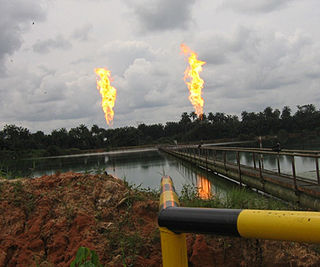Related Research Articles

A fossil fuel is a hydrocarbon-containing material formed underground from the remains of dead plants and animals that humans extract and burn as fuel. The main fossil fuels are coal, petroleum and natural gas, which humans extract through mining and drilling. Fossil fuels may be burnt to provide heat for use directly, to power engines, or to generate electricity.

Biofuel is a fuel that is produced over a short time span from biomass, rather than by the very slow natural processes involved in the formation of fossil fuels, such as oil. Since biomass can be used as a fuel directly, some people use the words biomass and biofuel interchangeably. However, the word biofuel is usually reserved for liquid or gaseous fuels, used for transportation. The U.S. Energy Information Administration (EIA) follows this naming practice.

Biodiesel is a form of diesel fuel derived from plants or animals and consisting of long-chain fatty acid esters. It is typically made by chemically reacting lipids such as animal fat (tallow), soybean oil, or some other vegetable oil with an alcohol, producing a methyl, ethyl or propyl ester by the process of transesterification.
An energy crisis is any significant bottleneck in the supply of energy resources to an economy. In literature, it often refers to one of the energy sources used at a certain time and place, in particular, those that supply national electricity grids or those used as fuel in industrial development and population growth have led to a surge in the global demand for energy in recent years. In the 2000s, this new demand – together with Middle East tension, the falling value of the US dollar, dwindling oil reserves, concerns over peak oil, and oil price speculation – triggered the 2000s energy crisis, which saw the price of oil reach an all-time high of $147.30 per barrel ($926/m3) in 2008.

The energy policy of the United States is determined by federal, state, and local entities in the United States, which address issues of energy production, distribution, and consumption, such as building codes and gas mileage standards. Energy policy may include legislation, international treaties, subsidies and incentives to investment, guidelines for energy conservation, taxation and other public policy techniques.
The United States produces mainly biodiesel and ethanol fuel, which uses corn as the main feedstock. The US is the world's largest producer of ethanol, having produced nearly 16 billion gallons in 2017 alone. The United States, together with Brazil accounted for 85 percent of all ethanol production, with total world production of 27.05 billion gallons. Biodiesel is commercially available in most oilseed-producing states. As of 2005, it was somewhat more expensive than fossil diesel, though it is still commonly produced in relatively small quantities.
Renewable Fuels are fuels produced from renewable resources. Examples include: biofuels and Hydrogen fuel. This is in contrast to non-renewable fuels such as natural gas, LPG (propane), petroleum and other fossil fuels and nuclear energy. Renewable fuels can include fuels that are synthesized from renewable energy sources, such as wind and solar. Renewable fuels have gained in popularity due to their sustainability, low contributions to the carbon cycle, and in some cases lower amounts of greenhouse gases. The geo-political ramifications of these fuels are also of interest, particularly to industrialized economies which desire independence from Middle Eastern oil.

A low-carbon economy (LCE) or decarbonised economy is an economy based on energy sources that produce low levels of greenhouse gas (GHG) emissions. GHG emissions due to anthropogenic (human) activity are the dominant cause of observed climate change since the mid-20th century. Continued emission of greenhouse gases may cause long-lasting changes around the world, increasing the likelihood of severe, pervasive, and irreversible effects for people and ecosystems.

Energy security is the association between national security and the availability of natural resources for energy consumption. Access to (relatively) cheap energy has become essential to the functioning of modern economies. However, the uneven distribution of energy supplies among countries has led to significant vulnerabilities. International energy relations have contributed to the globalization of the world leading to energy security and energy vulnerability at the same time.

The mitigation of peak oil is the attempt to delay the date and minimize the social and economic effects of peak oil by reducing the consumption of and reliance on petroleum. By reducing petroleum consumption, mitigation efforts seek to favorably change the shape of the Hubbert curve, which is the graph of real oil production over time predicted by Hubbert peak theory. The peak of this curve is known as peak oil, and by changing the shape of the curve, the timing of the peak in oil production is affected. An analysis by the author of the Hirsch report showed that while the shape of the oil production curve can be affected by mitigation efforts, mitigation efforts are also affected by the shape of Hubbert curve.

The Clean Cities Coalition Network is a coordinated group of nearly 100 coalitions in the United States working in communities across the country to advance affordable, domestic transportation fuels, energy efficient mobility systems, and other fuel-saving technologies and practices. The U.S. Department of Energy’s Office of Energy Efficiency and Renewable Energy’s Vehicle Technologies Office facilitates national coordination of the coalitions through its Technology Integration Program. The Network consists of 79 coalitions that work with more than 15,000 local stakeholders that have helped shift nearly 10 billion gasoline gallon equivalents of conventional fuel to alternative fuels or energy efficiency improvements, put more than 1.1 million alternative fuel vehicles on the road, and contributed to the expansion of alternative fueling station infrastructure since 1993. As of early 2020, there were more than 29,000 fueling stations nationwide that provide at least one of the following alternative fuels: ethanol (E85), biodiesel, compressed natural gas, electric, hydrogen, liquefied natural gas, renewable natural gas, or propane.

Algae fuel, algal biofuel, or algal oil is an alternative to liquid fossil fuels that uses algae as its source of energy-rich oils. Also, algae fuels are an alternative to commonly known biofuel sources, such as corn and sugarcane. When made from seaweed (macroalgae) it can be known as seaweed fuel or seaweed oil.

Sustainable biofuel is biofuel produced in a sustainable manner. It is not based on petroleum or other fossil fuels. It includes not using plants that are used for food stuff to produce the fuel thus disrupting the worlds food supply.
The Renewable Fuel Standard(RFS) is an American federal program that requires transportation fuel sold in the United States to contain a minimum volume of renewable fuels. It originated with the Energy Policy Act of 2005 and was expanded and extended by the Energy Independence and Security Act of 2007. Research published by the Government Accountability Office in November 2016 found the program unlikely to meet its goal of reducing greenhouse gas emissions due to limited current and expected future production of advanced biofuels.
The environmental impact of biodiesel is diverse and not clearcut. An often mentioned incentive for using biodiesel is its capacity to lower greenhouse gas emissions compared to those of fossil fuels. Whether this is true or not depends on many factors.
There are various social, economic, environmental and technical issues with biofuel production and use, which have been discussed in the popular media and scientific journals. These include: the effect of moderating oil prices, the "food vs fuel" debate, poverty reduction potential, carbon emissions levels, sustainable biofuel production, deforestation and soil erosion, loss of biodiversity, effect on water resources, the possible modifications necessary to run the engine on biofuel, as well as energy balance and efficiency. The International Resource Panel, which provides independent scientific assessments and expert advice on a variety of resource-related themes, assessed the issues relating to biofuel use in its first report Towards sustainable production and use of resources: Assessing Biofuels. In it, it outlined the wider and interrelated factors that need to be considered when deciding on the relative merits of pursuing one biofuel over another. It concluded that not all biofuels perform equally in terms of their effect on climate, energy security and ecosystems, and suggested that environmental and social effects need to be assessed throughout the entire life-cycle.
Carbon-based fuel is any fuel principally from the oxidation or burning of carbon. Carbon-based fuels are of two main kinds, biofuels and fossil fuels. Whereas biofuels are derived from recent-growth organic matter and are typically harvested, as with logging of forests and cutting of corn, fossil fuels are of prehistoric origin and are extracted from the ground, the principal fossil fuels being oil, coal, and natural gas.
Strict sustainability standards for biofuel in the European Union (EU) are set by the European Commissioner on Energy. Biofuels are considered a renewable alternative to fossil fuels in the transportation sector for the EU. The EU has played a large role in increasing the use of biofuels in member states; however, it has also aimed, to some extent, to mitigate the potential negative impacts of biofuel production. Current EU legislation on biofuels includes a goal to increase renewable energy consumption by 20%, eliminate biofuel feedstock sourced from carbon-rich land, accounting for emissions caused from land use change as well as solely biofuel usage, and reducing greenhouse gas intensities from fuels used in transport and machinery.
United States policy in regard to biofuels, such as ethanol fuel and biodiesel, began in the early 1990s as the government began looking more intensely at biofuels as a way to reduce dependence on foreign oil and increase the nation's overall sustainability. Since then, biofuel policies have been refined, focused on getting the most efficient fuels commercially available, creating fuels that can compete with petroleum-based fuels, and ensuring that the agricultural industry can support and sustain the use of biofuels.

Climate change in Tennessee encompasses the effects of climate change, attributed to man-made increases in atmospheric carbon dioxide, in the U.S. state of Tennessee.
References
- ↑ Nashville. "Nashville > Parks and Recreation > Nature Centers and Natural Areas". www.nashville.gov. Retrieved 2016-09-26.
- ↑ "Impacts of climate change on hydrology, water quality and crop productivity in the Ohio-Tennessee River Basin". Soil and Water Assessment Tool.
- ↑ "This page has moved - TN.gov". Archived from the original on 2008-07-23. Retrieved 2008-07-23.
- ↑ "Archived copy" (PDF). Archived from the original (PDF) on 2008-07-24. Retrieved 2008-07-23.
{{cite web}}: CS1 maint: archived copy as title (link) - ↑ Tennessee - State Best Practices | Clean Energy | US EPA